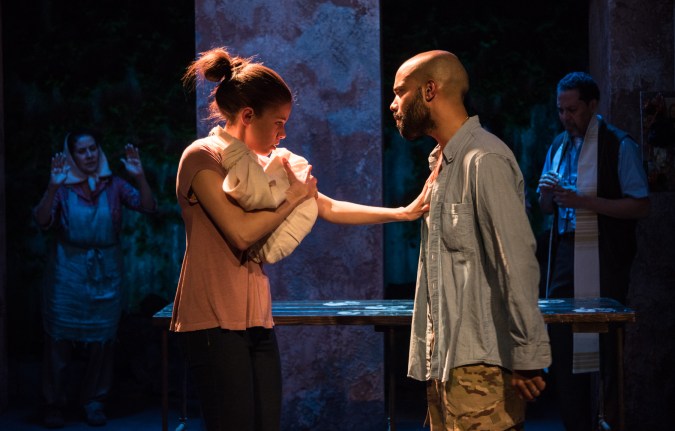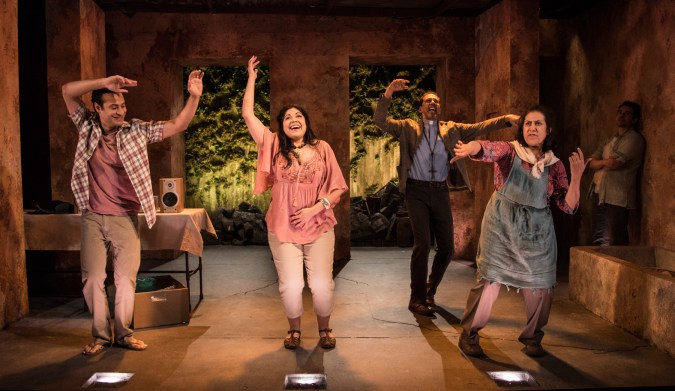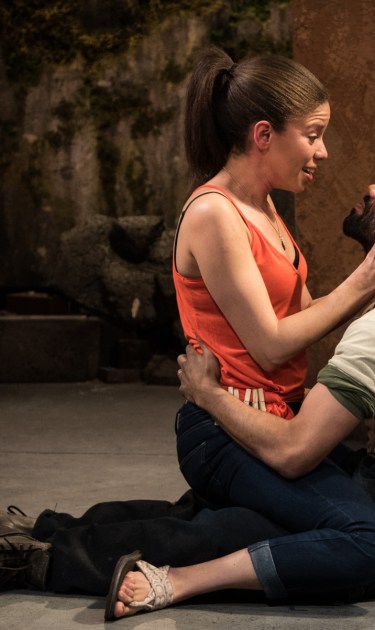Martín Zimmerman’s Seven Spots on the Sun, which opened last month at Rattlestick Playwrights Theater, is a striking on-stage vision, telling the kind of story we’re more familiar with in novels than theater: in a small, unnamed Latin-American town, a brutal war leads to an unsettled peace, a magical plague, and a man who devours whole pineapples in an attempt to reconnect with his lost love finds himself one day able to cure illness with a touch. Sitting in the audience, it struck me that the reason I was so unaccustomed to seeing magical realism come to life on stage was because of how few Latino writers get major productions.
The Sol Project, “a New York City-based theater initiative dedicated to producing works by Latinx playwrights, bringing the stories and culture of their community to the fore of American theater,” is here to change all that. Their mission: “elevate the visibility of Latinx writers in New York and nationally by activating a synergistic network of off-Broadway companies and regional theaters while prioritizing diversity within casts, crews and creative teams.” In English, the Sol Project seeks to partner with major theaters across the country to not only help produce new work, but to tap into those theaters’ communities to identify up and coming playwrights. Seven Spots on the Sun represents the Sol Project’s second partnership of a proposed twelve. I asked the Sol Projects’ founder, Jacob Padrón, about the project’s present and its future.

What makes an organization like the Sol Project necessary?
The Sol Project, hopefully, is helping to hold the American theater to its promise of being a space for all of our stories. In order for the theater to work its magic, to be a transformative catalyst, our stages must reflect the communities we live in. Unfortunately, we still live in a world where the stories and storytellers are homogeneous and don’t reflect the beautiful kaleidoscope of our shared experiences. Latinx artists are a part of that experience and we’ve been eclipsed for decades. And we continue to be eclipsed. The Sol Project is actively creating the space to tell our stories and lift up our artists.
What is a Latinx play?
I’m not sure there’s a way to essentially codify a “Latinx play.” I think what makes a Latinx play will depend on who you speak with and what their personal experience has been. For me, a Latinx play is a play written by a person who is of Latinx ancestry. For same writers, their plays are a platform to unpack questions about their ethnic identity. For others, it’s something completely different. But I appreciate that variety. We can hold both kinds of stories, and more.
I hope The Sol Project will become a national movement, with stages all across the country celebrating Latinx voices.
What was the moment where you realized this project had real momentum, that this was going to become something special?
I think the artistic collective and I are constantly pushing the momentum forward. Though we’ve had some early successes, and the support from the theater community has been pretty wonderful, we still have such a long way to go. There is still more funding to secure, more theaters to enlist as partners, more community leaders to serve as advocates, and more hard conversations to have about why The Sol Project matters.
How do you choose which plays go up?
The selection process of picking the writer and their play is very much a collaborative process between The Sol Project and the partner companies. With each theater we engage in a robust curatorial process, where we read and discuss a number of plays by writers we’re invested in supporting. First and foremost it’s about artistic excellence; that’s the first thing we’re looking at. Other considerations include: how is this writer/play in conversation with what’s happening in our world; how does this play push form and structure; how does this play sit within the larger story The Sol Project is trying to tell about Latindad; and how does this play work within the mission and aesthetic values of the partner company? So there are many considerations.

What’s the next play for the Sol Project?
Our next partnership will be with The Public Theater. It’s a really exciting team we’ve assembled, and this production will mark the New York debut for both the play and the playwright. I couldn’t be happier about this project. This is exactly the kind of space The Sol Project wants to make for a writer. This writer is one of our pillars in our Latinx theater community and his voice is so vital to our artistic ecosystem. This will be Sol #3! Nine more to go.
What’s your dream collaboration?
I firmly believe that great relationships make for great art. That being said, a dream collaboration would include a generosity of spirit that animates the entire process. I would love to figure out how to connect the West and East coast theaters, specifically our culturally specific companies who have been supporting artists of color for years. My first artistic home was El Teatro Campesino, an epicenter for social justice that created theater with, for, and by farm workers. How can we connect this important work to the rest of the theater community? That’s a question I’m wrestling with as a I think about future collaborations. I hope The Sol Project will become a national movement, with stages all across the country celebrating Latinx voices and that our experience makes its way in what future generations learn in the history books.




